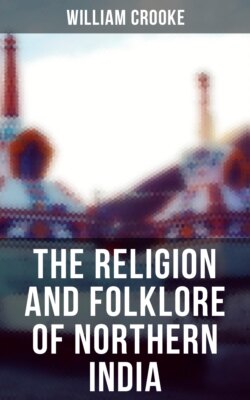Читать книгу The Religion and Folklore of Northern India - William Crooke - Страница 56
На сайте Литреса книга снята с продажи.
The Heroic Godlings.
ОглавлениеTable of Contents
Next to these deities which have been classed as the godlings of nature, come those which have a special local worship of their own. The number of these godlings is immense, and their functions and attributes so varied, that it is extremely difficult to classify them on any intelligible principle. Some of them are pure village godlings, of whom the last Census has unearthed an enormous number all through Northern India. Some of them, like Hanumân or Bhîmsen, are survivals in a somewhat debased form of the second-rate deities or heroes of the older mythology. Some have risen to the rank, or are gradually being elevated to the status, of national deities. Some are in all probability the local gods of the degraded races, whom we may tentatively assume to be autochthonous. Many of these have almost certainly been absorbed into Brâhmanism at a comparatively recent period. Some are in process of elevation to the orthodox pantheon. But it will require a much more detailed analysis of the national faith than the existing materials permit, before it will be possible to make a final classification of this mob of deities on anything approaching a definite principle.
The deities of the heroic class are as a rule benignant, and are generally worshipped by most Hindus. Those that have been definitely promoted into the respectable divine cabinet, like Hanumân, have Brâhmans or members of the ascetic orders as their priests, and their images, if not exactly admitted into the holy of holies of the greater shrines, are still allotted a respectable position in the neighbourhood, and receive a share in the offerings of the faithful.
The local position of the shrine very often defines the status of the deity. To many godlings of this class is allotted the duty of acting as warders (dwârapâla) to the temples of the great gods. Thus, at the Ashthbhuja hill in Mirzapur, the pilgrim to the shrine of the eight-armed Devî meets first on the road an image of the monkey god Hanumân, before he comes into the immediate presence of the goddess. So at Benares, Bhaironnâth is chief police officer (Kotwâl) or guardian of all the Saiva temples. Similarly at Jageswar beyond Almora we find Kshetrapâl, at Badarinâth Ghantakaran, at Kedârnâth Bhairava, and at Tungnâth Kâl Bhairon.1 In many places, as the pilgrim ascends to the greater temples, he comes to a place where the first view of the shrine is obtained. This is known as the Devadekhnî or spot from which the deity is viewed. This is generally occupied by some lower-class deity, who is just beginning to be considered respectable. Then comes the temple dedicated to the warden, and lastly the real shrine itself. There can be little doubt that this represents the process by which gods which are now admittedly within the inner circle of the first class, such as the beast incarnations of Vishnu, the elephant-headed Ganesa, and the Sâktis or impersonations of the female energies of nature, underwent a gradual elevation.
HANUMÂN AS A WARDEN.
This process is actually still going on before our eyes. Thus, the familiar Gor Bâba, a deified ghost of the aboriginal races, has in many places become a new manifestation of Siva, as Goreswara. Similarly, the powerful and malignant goddesses, who were by ruder tribes propitiated with the sacrifice of a buffalo or a goat, have been annexed to Brâhmanism as two of the numerous forms of Durgâ Devî, by the transparent fiction of a Bhainsâsurî or Kâlî Devî. In the case of the former her origin is clearly proved by the fact that she is regarded as a sort of tribal deity of the mixed tribe of Kânhpuriya Râjputs in Oudh. Similarly Mahâmâî, or the “Great Mother,” a distinctively aboriginal goddess whose shrine consists of a low flat mound of earth with seven knobs of coloured clay at the head or west side, has been promoted into the higher pantheon as Jagadambâ Devî, or “Mother of the World.” Her shrine is still a simple flat mound of earth with seven knobs at the top, and a flag in front to the east.2 More extended analysis will probably show that the obligations of Brâhmanism to the local cultus are much greater than is commonly supposed.
